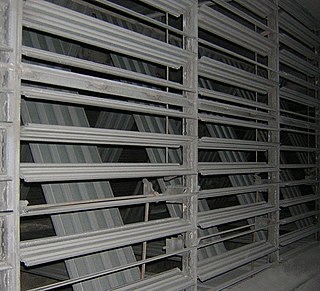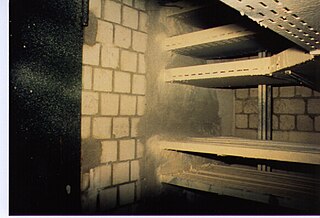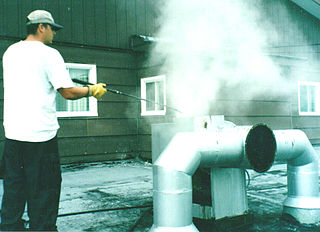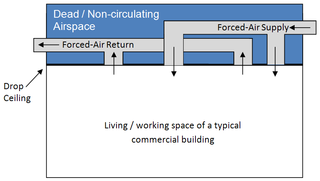This article needs additional citations for verification .(July 2014) |
Smoke dampers are passive fire protection products used in air conditioning and ventilation ductwork or installed in physical smoke barriers (e.g., walls).
This article needs additional citations for verification .(July 2014) |
Smoke dampers are passive fire protection products used in air conditioning and ventilation ductwork or installed in physical smoke barriers (e.g., walls).
Smoke damper may be used to prevent the spread of smoke from the space of fire origin to other spaces in the same building. A combination of fans and dampers can exhaust smoke from an area while pressurizing the smoke-free areas around the affected area (inhibiting smoke infiltration into additional areas). It may also be used to maintain the required concentration of a fire suppression clean agent in a space, as installed in supply air ducts to restrict the introduction of air into the space, and as installed in return or exhaust air ducts to restrict the depletion of the clean agent from the space. Smoke dampers are usually installed by sheet metal contractors.
Smoke dampers can be activated by the fire alarm system, usually initiated by smoke detectors, or interlocked with a fire suppression system. Smoke dampers close by an electric or pneumatic actuator, or a spring actuator, and can be either manually reset or driven open on a reset signal to the electric or pneumatic actuator.
Combination fire/smoke dampers are also available if a smoke barrier is desired at the same location as a fire barrier.
Fire dampers and smoke dampers are an integral and essential part of a building's passive fire protection system. [1]
As with any other element of a building's passive fire protection system, smoke dampers need to be maintained, inspected and repaired to ensure they are in working order. The National Fire Protection Association (NFPA) requires the testing, maintenance and repair of smoke dampers as mandated in the Life Safety Code. NFPA 105 states [that] each damper shall be tested and inspected one year after installation. The test and inspection frequency shall then be every 4 years, except in hospitals, where the frequency shall be every 6 years. The code also states that the damper shall be actuated and cycled. The inspections must be document indicating the location of the damper, date of inspection, name of inspector, and deficiencies discovered. [2]
As with fire damper inspections, smoke damper inspections are required by Authorities Having Jurisdiction (AHJ's). The International Code Council, the Joint Commission, NFPA and State Fire Marshals require these inspections as part of a Building's Life Safety Plan.
NFPA 105 requires that "if a damper is not operable, repairs shall begin as soon as possible". [3] The repair of smoke dampers is more complicated as compared to fire dampers due to actuator replacement.
According to Underwriter's Laboratory, "smoke dampers certified by UL carry a leakage class rating that indicates the level of air leakage measured through the damper under test conditions." [4]

A firewall is a fire-resistant barrier used to prevent the spread of fire. Firewalls are built between or through buildings, structures, or electrical substation transformers, or within an aircraft or vehicle.

A fire sprinkler system is an active fire protection method, consisting of a water supply system providing adequate pressure and flowrate to a water distribution piping system, to which fire sprinklers are connected. Although initially used only in factories and large commercial buildings, systems for homes and small buildings are now available at a cost-effective price.

A fire alarm notification appliance is an active fire protection component of a fire alarm system. A notification appliance may use audible, visible, or other stimuli to alert the occupants of a fire or other emergency condition requiring action. Audible appliances have been in use longer than any other method of notification. Initially, all appliances were either electromechanical horns or electric bells, which would later be replaced by electronic sounders. Most of today's appliances produce sound levels between 70 and 100 decibels at three feet.

A kitchen hood, exhaust hood, hood fan, extractor hood, or range hood is a device containing a mechanical fan that hangs above the stove or cooktop in the kitchen. It removes airborne grease, combustion products, fumes, smoke, heat, and steam from the air by evacuation of the air and filtration. In commercial kitchens exhaust hoods are often used in combination with fire suppression devices so that fumes from a grease fire are properly vented and the fire is put out quickly. Commercial vent hoods may also be combined with a fresh air fan that draws in exterior air, circulating it with the cooking fumes, which is then drawn out by the hood.

A damper is a valve or plate that stops or regulates the flow of air inside a duct, chimney, VAV box, air handler, or other air-handling equipment. A damper may be used to cut off central air conditioning to an unused room, or to regulate it for room-by-room temperature and climate control - for example, in the case of Volume Control Dampers. Its operation can be manual or automatic. Manual dampers are turned by a handle on the outside of a duct. Automatic dampers are used to regulate airflow constantly and are operated by electric or pneumatic motors, in turn controlled by a thermostat or building automation system. Automatic or motorized dampers may also be controlled by a solenoid, and the degree of air-flow calibrated, perhaps according to signals from the thermostat going to the actuator of the damper in order to modulate the flow of air-conditioned air in order to effect climate control.

A fire door is a door with a fire-resistance rating used as part of a passive fire protection system to reduce the spread of fire and smoke between separate compartments of a structure and to enable safe egress from a building or structure or ship. In North American building codes, it, along with fire dampers, is often referred to as a closure, which can be derated compared against the fire separation that contains it, provided that this barrier is not a firewall or an occupancy separation. In Europe national standards for fire doors have been harmonised with the introduction of the new standard EN 16034, which refers to fire doors as fire-resisting door sets. Starting September 2016, a common CE marking procedure was available abolishing trade barriers within the European Union for these types of products. In the UK, it is Part B of the Building Regulations that sets out the minimum requirements for the fire protection that must be implemented in all dwellings this includes the use of fire doors. All fire doors must be installed with the appropriate fire resistant fittings, such as the frame and door hardware, for it to fully comply with any fire regulations.
Active fire protection (AFP) is an integral part of fire protection. AFP is characterized by items and/or systems, which require a certain amount of motion and response in order to work, contrary to passive fire protection.

A fire alarm system is a building system designed to detect, alert occupants, and alert emergency forces of the presence of fire, smoke, carbon monoxide, or other fire-related emergencies. Fire alarm systems are required in most commercial buildings. They may include smoke detectors, heat detectors, and manual fire alarm activation devices. All components of a fire alarm system are connected to a fire alarm control panel. Fire alarm control panels are usually found in an electrical or panel room. Fire alarm systems generally use visual and audio signalization to warn the occupants of the building. Some fire alarm systems may also disable elevators, which are unsafe to use during a fire under most circumstances.
A firestop or fire-stopping is a form of passive fire protection that is used to seal around openings and between joints in a fire-resistance-rated wall or floor assembly. Firestops are designed to maintain the fire-resistance rating of a wall or floor assembly intended to impede the spread of fire and smoke.

Passive fire protection (PFP) is components or systems of a building or structure that slows or impedes the spread of the effects of fire or smoke without system activation, and usually without movement. Examples of passive systems include floor-ceilings and roofs, fire doors, windows, and wall assemblies, fire-resistant coatings, and other fire and smoke control assemblies. Passive fire protection systems can include active components such as fire dampers.
Within the context of building construction and building codes, occupancy is the use of a building for the shelter or support of persons, animals or property. A closely related meaning is the number of units in such a building that are rented, leased, or otherwise in use. Lack of occupancy, in this sense, is known as vacancy.

Ducts are conduits or passages used in heating, ventilation, and air conditioning (HVAC) to deliver and remove air. The needed airflows include, for example, supply air, return air, and exhaust air. Ducts commonly also deliver ventilation air as part of the supply air. As such, air ducts are one method of ensuring acceptable indoor air quality as well as thermal comfort.
The Air Movement and Control Association International, Inc. (AMCA) is an American trade body that sets standards for Heating, Ventilation and Air Conditioning (HVAC) equipment. It rates fan balance and vibration, aerodynamic performance, air density, speed and efficiency.

A fire test is a means of determining whether fire protection products meet minimum performance criteria as set out in a building code or other applicable legislation. Successful tests in laboratories holding national accreditation for testing and certification result in the issuance of a certification listing.
Heat and smoke vents are installed in buildings as an active fire protection measure. They are openings in the roof which are intended to vent the heat and smoke developed by a fire inside the building by the action of buoyancy, such that they are known as "gravity vents".

A grease duct is a duct that vents grease-laden flammable vapors from commercial cooking equipment such as stoves, deep fryers, and woks to the outside of a building or mobile food preparation trailer. Grease ducts are part of the building's passive fire protection system. The cleaning schedule is typically dictated by fire code or related safety regulations.

Fire dampers are passive fire protection products used in heating, ventilation, and air conditioning (HVAC) ducts to prevent and isolate the spread of fire inside the ductwork through fire-resistance rated walls and floors. Fire/smoke dampers are similar to fire dampers in fire resistance rating, and also prevent the spread of smoke inside the ducts. When a rise in temperature occurs, the fire damper closes, usually activated by a thermal element which melts at temperatures higher than ambient but low enough to indicate the presence of a fire, allowing springs to close the damper blades. Fire dampers can also close following receipt of an electrical signal from a fire alarm system utilising detectors remote from the damper, indicating the sensing of heat or smoke in the building occupied spaces or in the HVAC duct system.

A plenum space is a part of a building that can facilitate air circulation for heating and air conditioning systems, by providing pathways for either heated/conditioned or return airflows, usually at greater than atmospheric pressure. Space between the structural ceiling and the dropped ceiling or under a raised floor is typically considered plenum; however, some drop-ceiling designs create a tight seal that does not allow for airflow and therefore may not be considered a plenum air-handling space.
In building safety and construction, a smokeproof enclosure is a type of exit stairwell that has been designed to keep out smoke in the event of a fire, so that building occupants may more safely exit the building.
EN 16034 is a set of European standards which specify the technical performance characteristics for fire resistant and smoke control products, such as fire doors. Compliance with this standard requires to fulfill the requirements of the Construction Product Regulation for construction products.